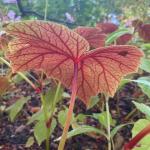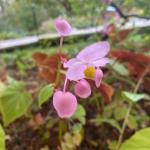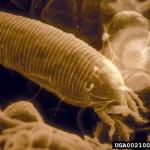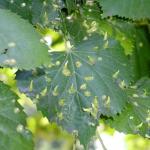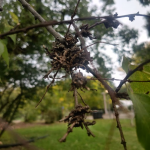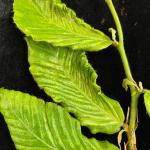A monthly e-newsletter from UMass Extension for landscapers, arborists, and other Green Industry professionals, including monthly tips for home gardeners.
To read individual sections of the message, click on the section headings below to expand the content.
To print this issue, either press CTRL/CMD + P or right click on the page and choose Print from the pop-up menu.
New Northeast RISCC Management Fact Sheet: Ornamental Invasive Plants to Avoid with Climate Change
The Regional Invasive Species & Climate Change (RISCC) Management Networks research group has developed a fact sheet about some recent work on invasive plant species and climate change titled Regional Invasive Species & Climate Change Management Challenge: Do Not Sell! Ornamental invasive plants to avoid with climate change.
Climate change is likely to bring dozens of new invasive plants to the Northeast. Despite their invasive tendencies, many of these species are sold as ornamental plants in slightly warmer climates, but are not yet a large part of nursery sales in the Northeast. By avoiding these species, we protect our native ecosystems from future invasive species impacts. The fact sheet also presents alternative native plants that provide similar aesthetics while also supporting biodiversity.
The RISCC management networks reduce the joint effects of climate change and invasive species by synthesizing relevant science, sharing the needs and knowledge of managers, building stronger scientist-manager communities, and conducting priority research. To read the fact sheet, go to https://scholarworks.umass.edu/eco_ed_materials/14/
Featured Plant
Hardy begonia, Begonia grandis
Recently, a client offered me a young perennial taken from a larger population that she has had growing underneath a crabapple tree for the past fifteen plus years. When I noted that the plant looked very much like a begonia, she informed me that it was indeed a begonia. She smiled at my incredulous expression and went on to explain that, unlike its more tender relatives, this was a hardy begonia, Begonia grandis (sometimes classified as Begonia grandis subsp. evansiana). Intrigued, I decided to investigate this attractive, tropical-looking species able to tolerate almost two decades of snowy Berkshire winters.
Native to Southern China and Japan, hardy begonia is listed as suitable for growing anywhere from zones 5, 6, or 7 to zone 9, depending on the reference consulted, but is most often recommended for zones 6 to 9. I would argue that my client’s success with the plant in zone 5a bodes well for gardeners in colder regions of the state that may want to experiment with growing it, with certain caveats (see Cultivation below).
Characteristics and Ornamental Features
Hardy begonia grows as a clump of arching stems, from 1 to 2 feet in height, adorned with asymmetrical wing-like leaves that reach up to 4 inches in length. The dark olive-green upper surfaces of the leaves are attractive but pale in comparison to the incredibly showy reddish undersides. This feature is best appreciated when plants are positioned to be viewed from all sides, such as in an island bed.
Like the leaves, hardy begonia flowers are also noteworthy: white to pink hued, each up to an inch in size, and occurring in dangling clusters. Plants begin blooming in July or August and flowering can be prolonged through early fall by regular deadheading.
Cultivation
Hardy begonia is most successfully grown in soil that is rich in organic matter and is moist but not soggy, as wet soil may lead to root rot. It prefers a site in part shade to full shade. Several references mention the need to mulch well in the fall to ensure the plant overwinters in colder zones; my client’s begonia location under a mature crabapple tree appears to give both necessary shade during the growing season as well as overwintering protection in the form of fallen leaves and sheltering branches. Hardy begonia has no significant pest or disease problems, and while it naturalizes readily, it is not difficult to contain in a desired area. The plant grows companionably in perennial borders and woodland gardens with other shade-lovers: ferns, hostas, Pulmonaria, hellebore, and Hakonechloa.
Hardy begonia reproduces itself from seed as well as asexually from small bulblets that develop in the leaf axils in the fall. Leaving plants to decompose in place at the end of the season will allow any propagules to drop to the ground and increase the size of the colony the following year. Mark any areas of hardy begonia to be preserved, as plants are slow to show signs of emerging in the spring.
Cultivars/Varieties
Begonia grandis subsp. evansiana 'Alba': white flowers
Begonia grandis 'Pink Teardrops': bright pink flowers, extremely floriferous
Begonia grandis ‘Wildwood Premier’: more pronounced red color on leaves
Begonia grandis ‘Heron’s Pirouette’: large flower clusters
References
Missouri Botanical Garden. (n.d.). Begonia grandis fact sheet.
North Carolina State Cooperative Extension. (n.d.). Begonia grandis fact sheet.
Plant Delights Nursery. (2022). Begonia grandis fact sheet.
Rostaing, J. (2019). Hardy begonia: Summer blooms and wonderful foliage in the shade.
Tsamtsis, P. (n.d.). Begonia grandis ssp. evansiana fact sheet.
Jennifer Kujawski, Horticulturist
Trouble Maker of the Month
Dry and Hot Weather Effects on Insect and Arthropod Pests
Effect of temperature: Do insect pest benefit from the hot weather?
Insects are cold blooded organisms and cannot control their body temperature, meaning that their growth and development depends on and is often limited by the temperature of their surroundings. The relationship between rate of insect development and temperature are not linear.
For most insects, no development, growth, or activity occurs below a certain temperature threshold (50°F in the northeastern United states). If the temperature rises above the threshold, the rate of insect development will steadily increase, eventually reaching the optimal temperature. If the temperature is optimal, insects grow faster and larger, survive better, have more generations in the given year, and produce more offspring regardless of food quality [2-3]. Very high temperatures can also negatively affect insect activity, growth, and development. Thus, if the temperature continues to increase beyond optimal range, the developmental rate rapidly drops and eventually insects stop developing and go into aestivation, a state of arrested development and activity. Therefore, during heatwaves, instead of the expected fast pest development, the opposite trend can be observed.
For many pests, prolonged hot weather creates ideal conditions for growth, development, and reproduction. Not only is hot weather favorable for fast insect growth and development, but the heat also affects host plants by reducing their capacity to recover and tolerate insect feeding; exacerbating the damage caused by the insect pest. On another note, under elevated temperatures, insect are not efficient at food processing and compensate by feeding more, causing more feeding relating damage than usual [3].
Effect of drought: what pests to watch out for under the drought conditions?
During dry conditions, the nutritional quality of plant tissues changes in favor of the insect pests. Many studies reported elevated protein and carbohydrate content in drought stressed plants, which means that during dry conditions plants have increased nutritional quality for insect pests [4]. Another reason why drought-stressed plants can be more attractive to insect pests is weakened plant defenses. Many plants produce secondary chemicals which are toxic or repel insect pests. However, during droughts, the concentration of these defense chemicals significantly decreases and the plant becomes more attractive to various insect pests. As result, the pest host range can expand and pest outbreaks (leaf chewers, miners, gall makers and sap feeders) are very common under the prolonged drought stress.
Different pest species are more prevalent at different levels of drought. For example, bark beetle outbreaks occur and can be devastating during severe droughts [4-5]. Sap-feeding pests usually thrive under moderate, less severe drought conditions. Studies have demonstrated that drought-stressed oak trees had more aphids and lace bugs than un-stressed oaks. Similarly, scale infestations are more severe on their drought stressed hosts [2-4]. Warm temperatures, as discussed previously, shorten the developmental time and favor growth and reproduction. Drought will cause changes in the host plant, making it more nutritious and less toxic. The combination of dry and hot conditions work in synergy favoring pests and putting the host plants under the stress, decreasing its ability to tolerate and/or fight off the infestations.
Mite infestations during hot and dry spells during 2020- 2022.
Mites are a group of pests that thrive under hot and dry conditions. Mite development speeds up and females lay more eggs under such conditions, therefore their infestations and damage are usually more apparent. Hot temperatures and prolonged dry spells in recent years favored mite infestation in landscapes, resulting in severe mite outbreaks being observed frequently.
Mites technically are not insects, belonging to the class Arachnida, and are close “relatives” of spiders, ticks, and harvestmen. Mites are very small and usually are unnoticeable until damage is visible. Two major groups of pest mites most observed in landscapes are spider mites and Eriophyid mites.
Spider mites
Spider mites have a silk gland close to their mouthparts and can produce webs, similar to spiders. They are very small arthropods with eight legs and two body regions (Figure 1). Spider mites usually feed on the top surface of leaves by rupturing the surface cell with their needle-like mouthparts and then feeding on the cell contents. As a result, they destroy the chlorophyll-bearing cells on the surface or underside of the leaf, which results in flecking, stippling, bleaching and/or bronzing (Figure 2, 3). Mites can develop from an egg to adult in just a few days and can complete several generations during the growing season. Each females lays many eggs every day and can lay up to 100 eggs through their lifetime. Therefore, rapid development and reproduction is usually observed during hot and dry season, often affecting the entire plant. Unlike insects, mites do not have wings, and are usually dispersed by wind and hitchhike birds to get to a new host.

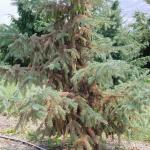
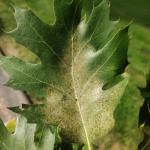 Spider mites have a relatively wide host range and many different mite species can be problematic. For example, on deciduous plants the following genera occur: Bryiobia, Panonychus, Eurytetranychus, Eotetranychus, Schizotetranychus, Oligonychus and Tetranychus. A wide range of hosts can be affected by mites; the most common are oak trees (mostly red and pin oaks) (Figure 3), linden trees, honeylocust, black locust, elms, birch, and others. On conifers, most destructive damage is caused by species in the genus Olygonichus (Figure 1, 2). Severe infestation of spruce spider mites are common on most spruce species, arborvitae, juniper, hemlock, pines, and other conifers.
Spider mites have a relatively wide host range and many different mite species can be problematic. For example, on deciduous plants the following genera occur: Bryiobia, Panonychus, Eurytetranychus, Eotetranychus, Schizotetranychus, Oligonychus and Tetranychus. A wide range of hosts can be affected by mites; the most common are oak trees (mostly red and pin oaks) (Figure 3), linden trees, honeylocust, black locust, elms, birch, and others. On conifers, most destructive damage is caused by species in the genus Olygonichus (Figure 1, 2). Severe infestation of spruce spider mites are common on most spruce species, arborvitae, juniper, hemlock, pines, and other conifers.
Spider mites have many natural enemies that keep their populations in check. Application of broad-spectrum insecticides often exacerbates infestations of spider mites [9] because it removes natural enemies and in some cases stimulates mite reproduction [9]. The best strategies to prevent or combat mite infestation is to reduce plant stress by providing adequate irrigation and fertilization. Insecticides and horticultural oils can also be used to manage spider mites.
Eriophyid mites
Mites of the family Eriopyidae (Figure 4) are commonly associated with the galls which are abnormal growths of the plant tissue in response to the mites’ presence and feeding (Figure 5). Mites feed inside of the formation and stay protected from adverse weather and predators. Gall tissue is modified plant tissues which is rich in nutrients, providing the mites with an excellent food source. The size and appearance of the galls created by Eriophyid mites varies depending on the host and mite species. Although mites are very small and often cannot be detected by the naked eye, unique galls are a very precise tool in mite species identification. The most common types of galls are spindle (Figure 5, 6), felt, bladder, blister galls and others. The management recommendations for Eriophyid mites are similar to spider mite management; however, sometimes good control is harder to achieve because mites feed inside of the galls.
References
- NOAA National Integrated Drought Information System
- Mary A Jamieson, Laura A Burkle, Jessamyn S Manson, Justin B Runyon, Amy M Trowbridge, Joseph Zientek, Global change effects on plant–insect interactions: the role of phytochemistry, Current Opinion in Insect Science,Volume 23,2017, pages 70-80.
- Cregg B, Dix M. (2001). Tree moisture stress and insect damage in urban areas in relation to heat island effects. Journal of Arboriculture. 27: 8-17.
- Mattson WJ, Haack RA. (1987) The role of drought in outbreaks of plant-eating insects. BioScience. 37: 110–118.
- McIntyre NE. (2000). Ecology of urban arthropods: A review and a call to action. Annals of the Entomological Society of America. 93:825–835.
- Speight MR, Hails RS, Gilbert M, Foggo A. (1998) Horse Chestnut Scale (Pulvinaria regalis) (Homoptera: Coccidae) and urban host tree environment. Ecology. 79:1503–1513.
- Dale AG, Frank SD. (2017). Warming and drought combine to increase pest insect fitness on urban trees. PLoS One. 12
- Koricheva J, Larsson S, Haukioja E (1998). Insect performance on experimentally stressed woody plants: A meta-analysis. Annual Review of Entomology. 43: 195–216. 10.1146/annurev.ento.43.1.195
- Szczepaniec A, Creary SF, Laskowski KL, Nyrop JP, Raupp MJ (2011) Neonicotinoid Insecticide Imidacloprid Causes Outbreaks of Spider Mites on Elm Trees in Urban Landscapes. PLOS ONE 6(5): e20018.
Olga Kostromytska, Extension Assistant Professor of Turf Entomology, UMass Amherst
Q&A
Q. What management options are available to control beech leaf disease (BLD)?
A. Beech leaf disease is caused by the foliar nematode Litylenchus crenatae ssp. mccanii. The BLD nematode is strongly believed to be non-native in North America and can readily infest American (Fagus grandifolia) and European beech (F. sylvatica). Nematodes are microscopic, rounded, non-segmented worms in kingdom Animalia. Historically, they have been studied by plant pathologists and are important pests of turfgrasses and vegetable crops. The current situation with beech leaf disease is unprecedented; there has never been a documented case of a foliar nematode causing widespread tree mortality. Therefore, identifying successful management strategies has been a major challenge without any frame of reference. The disease is spreading rapidly across Massachusetts and many infected trees are quickly declining.
Presently, phosphites (Agri-FosTM, ReliantTM, Polyphosphite 30TM) have been shown to reduce populations of the BLD nematode in infested trees. However, it may take several years of treatment to see a notable improvement in tree vigor. Phosphites can be applied by drenching the soil around the base of the tree or by spraying the lower trunk of infested beech. This systemic fungicide moves readily in the tree’s vascular system. Currently, it’s not understood how phosphites reduce nematode populations, but trials are continuing. Phosphites have two modes of action, with one acting as a weak fungicide and the second working to stimulate the tree’s natural defense response. Phosphites are not a fertilizer and do not provide plants with a usable source of phosphorous.
Recent research has suggested that fluopyram is effective in controlling the BLD nematode. Fluopyram is a relatively new chemical that was approved for use by the EPA in 2012. It has efficacy as both a fungicide and nematicide in woody and non-woody plants. Several studies have shown fluopyram provides effective control over an array of plant pathogenic nematodes. This chemical is locally systemic and can be applied as a foliar spray. Currently, there are no products that contain only fluopyram that are labeled for use on trees in landscape settings. There are two combination products labeled for use on trees (BroadformTM and Luna ExperienceTM). Broadform (fluopyram + trifloxystrobin) is the only one labeled for use in commercial landscape settings and could be used to treat BLD. However, in accordance with good IPM practices, this product must be rotated with alternate chemicals to reduce the risk of resistance development. IndemnifyTM is a product that contains fluopyram only, but is labeled for turfgrasses.
Early laboratory trials showed that the insecticide emamectin benzoate kills the BLD nematode. However, injections of this chemical into infested beech has produced limited to no control. Uptake in trees has been an issue and further use is not recommended.
The BLD nematode has proven very adept at traveling long distances into seemingly remote areas. While the specific vectors remain unknown, insects and birds are strongly suspected. Some movement has occurred on nursery stock, but this does not represent the primary means of dispersal. Regardless, carefully examine any beech nursery stock for symptoms of the disease. BLD symptoms are present when leaves emerge, so the disease can be diagnosed very early in the growing season.
Nick Brazee, UMass Extension Plant Pathologist
Garden Clippings Tips of the Month
October is the month to . . . .
-
Keep the leaves. Fallen leaves are a valuable resource for the landscape. Leaves make good mulches, help build soil organic matter as they decompose, and may also provide valuable habitat for invertebrates that overwinter in leaf litter. Leaves from walkways, driveways, patios, and lawns can be collected and reused as mulch in borders and natural areas. Leaves on lawns may also be mulch mown. Leaves in garden beds, borders, and natural areas can be left or if necessary, removed, chopped and replaced. One caution with keeping leaves regards foliar diseases; some foliar diseases such as anthracnose survive on fallen leaves and may be a source of disease inoculum the following season, so caution should be exercised in such situations. Leaves under certain circumstances can also create more hospitable conditions for ticks... see "Leave the Leaves" article below.
-
Water as needed. If drought and low soil moisture continue into fall, continue to provide supplemental water. Drought stressed and/or damaged plants are more likely to suffer from winter injuries. Broadleaved and needled evergreens are particularly susceptible to increased winter injury because of low soil moisture.
-
Finish planting and relocating. Indigenous People’s Day is a good target to have your planting, dividing and plant moving projects finished to allow time for root establishment. Mulch well to protect the root zone and reduce potential of winter heaving.
-
Dig summer bulbs and plant spring flowering bulbs. Summer bulbs such as cannas, dahlias, elephant ears, gladiolus, and tuberous begonias should be dug after the first light frost. Dig bulbs on a dry day. Instead of washing soil off, let air dry and lightly brush off the soil. Store in peat moss or sawdust in a location that is cool, dry and dark.
-
Plant spring flowering bulbs such as crocuses, daffodils, hyacinths, squills and tulips. To get the best display, plant in large masses. Use hardware cloth or chicken wire over planted areas to deter critters like squirrels and chipmunks from digging and eating bulbs.
-
Test your soil. Make sure to follow the proper instruction for taking soil samples; a soil test's recommendations are only as good as the sample submitted. https://ag.umass.edu/services/soil-plant-nutrient-testing-laboratory
-
Plant garlic. Garlic should be planted shortly after the first frost and before regular hard freezes (25-28oF), which is typically in October or early November in Massachusetts. Plant only the largest cloves, since larger cloves produce larger bulbs. Plant about a finger length deep. Mulch with several inches of straw or chopped leaf mulch. There are two types of garlic: hardneck and softneck. Hardneck garlic produces a scape, often has purple coloration in the paper covering, and produces fewer larger cloves per bulb. Softneck garlic typically produce more cloves, stores longer and is easier to braid.
-
Push the limits of fall production in the vegetable garden. Floating row fabrics can be used to provide some frost protection on frost sensitive crops or push the season longer on cool season crops. Lightweight (0.5 oz/sq. yd) row fabrics provide 2-4oF protection; heavy weight (1.5-2oz/sq. yd) row fabrics can provide 5-8oF of protection.
-
Keep an eye out for the invasive spotted lanternfly; learn how to identify the various life stages at https://www.massnrc.org/pests/pestFAQsheets/spottedlanternfly.html
Russ Norton, Agriculture & Horticulture Extension Educator, Cape Cod Cooperative Extension
Leave the Leaves: Save the Moths, Save Your Back, Save the TICKS?
One of the best things you can do to support a bevy of bugs is to “leave the leaves.” Leaves provide natural insulation for overwintering bees, fireflies, butterflies, and moths. Fallen plant matter will slowly break down and improve soil quality. “Leaving the leaves” will also save you money, time, and your back. This all sounds like a win-win. But there is another organism that benefits from a yard full of leaves: deer ticks. Like other native organisms, deer ticks are well-adapted to New England. They take full advantage of the natural cycles that play out around us.
Leaves protect deer ticks and allow them to thrive during the cold winter season. Any time temperatures are above 32oF, there can be tick activity. Deer ticks are highly susceptible to desiccation. In fact, they need ~82% humidity or higher. Fall and winter ambient air temperatures are far too dry for ticks live very long. However, under the moist microclimate leaves provide, ticks can recover moisture ad libitum. Leaves also provide insulation for deer ticks during the winter. They can survive below freezing temperatures to some extent. However, they eventually succumb and perish if temperatures drop too low. A blanket of leaves will buffer low swings in temperatures and protect deer ticks.
To be clear, I’m not against “leaving the leaves.” As mentioned above, there are many good reasons to do so. The message here is that when we do, our yards become more hospitable to ticks. It’s an important detail left out of many conservation messages. If we decide to “leave the leaves,” then we need to be educated and aware. There are benefits, but there are also risks. Every time we (and our pets) traverse over fallen leaves, we face the risk of encountering ticks. A leaf-free yard is a hostile environment for deer ticks. You may still find some, but your chances will be much lower than a yard covered in leaves.
Take heed around edges bordering woodlands, as these are high risk locations even without the leaves. Piling of leaves in these locations will only enhance that risk. We may not cross these areas often, but our pets often do. You can compromise. Clean up heavily used locations but “leave the leaves” everywhere else.
As for me, I’m a conservationist and a giant bug nerd. I’ll be leaving the leaves this fall and focusing on personal protection. Repellents, permethrin-treated clothing, and tick checks are already part of my toolbox and have kept me Lyme-free my whole life.
Blake Dinius, Entomologist, Plymouth County
Upcoming Events
For details and registration options for upcoming events, go to the UMass Extension Landscape, Nursery, and Urban Forestry Program Upcoming Events Page.
Pesticide Exam Preparation and Recertification Courses
These workshops are currently being offered online. Contact Natalia Clifton at nclifton@umass.edu or go to https://www.umass.edu/pested for more info.
InsectXaminer!
Episodes so far featuring gypsy moth, lily leaf beetle, euonymus caterpillar, imported willow leaf beetle, and spotted lanternfly can be found at: https://ag.umass.edu/landscape/education-events/insectxaminer
TickTalk with TickReport Webinars
To view recordings of past webinars in this series, go to: https://ag.umass.edu/landscape/education-events/ticktalk-with-tickreport-webinars
Additional Resources
For detailed reports on growing conditions and pest activity – Check out the Landscape Message
For professional turf managers - Check out our Turf Management Updates
For commercial growers of greenhouse crops and flowers - Check out the New England Greenhouse Update website
For home gardeners and garden retailers - Check out our home lawn and garden resources
Diagnostic Services
Landscape and Turf Problem Diagnostics - The UMass Plant Diagnostic Lab is accepting plant disease, insect pest and invasive plant/weed samples. By mail is preferred, but clients who would like to hand-deliver samples may do so by leaving them in the bin marked "Diagnostic Lab Samples" near the back door of French Hall. The lab serves commercial landscape contractors, turf managers, arborists, nurseries and other green industry professionals. It provides woody plant and turf disease analysis, woody plant and turf insect identification, turfgrass identification, weed identification, and offers a report of pest management strategies that are research based, economically sound and environmentally appropriate for the situation. Accurate diagnosis for a turf or landscape problem can often eliminate or reduce the need for pesticide use. See our website for instructions on sample submission and for a sample submission form at http://ag.umass.edu/diagnostics.
Soil and Plant Nutrient Testing - The lab is accepting orders for Routine Soil Analysis (including optional Organic Matter, Soluble Salts, and Nitrate testing), Particle Size Analysis, Pre-Sidedress Nitrate (PSNT), and Soilless Media (no other types of soil analyses available at this time). Testing services are available to all. The lab provides test results and recommendations that lead to the wise and economical use of soils and soil amendments. For updates and order forms, visit the UMass Soil and Plant Nutrient Testing Laboratory web site.
Tick Testing - The UMass Center for Agriculture, Food, and the Environment provides a list of potential tick identification and testing options at: https://ag.umass.edu/resources/tick-testing-resources.

